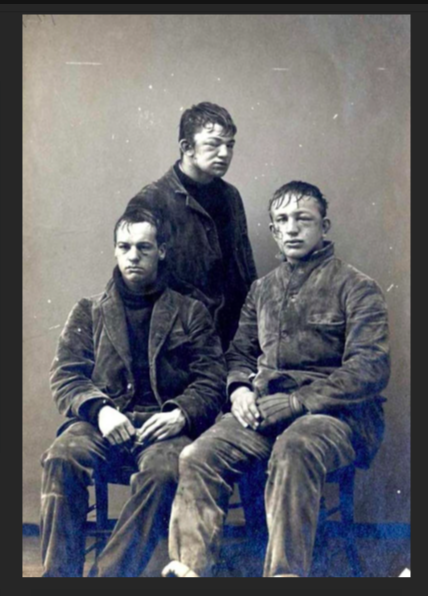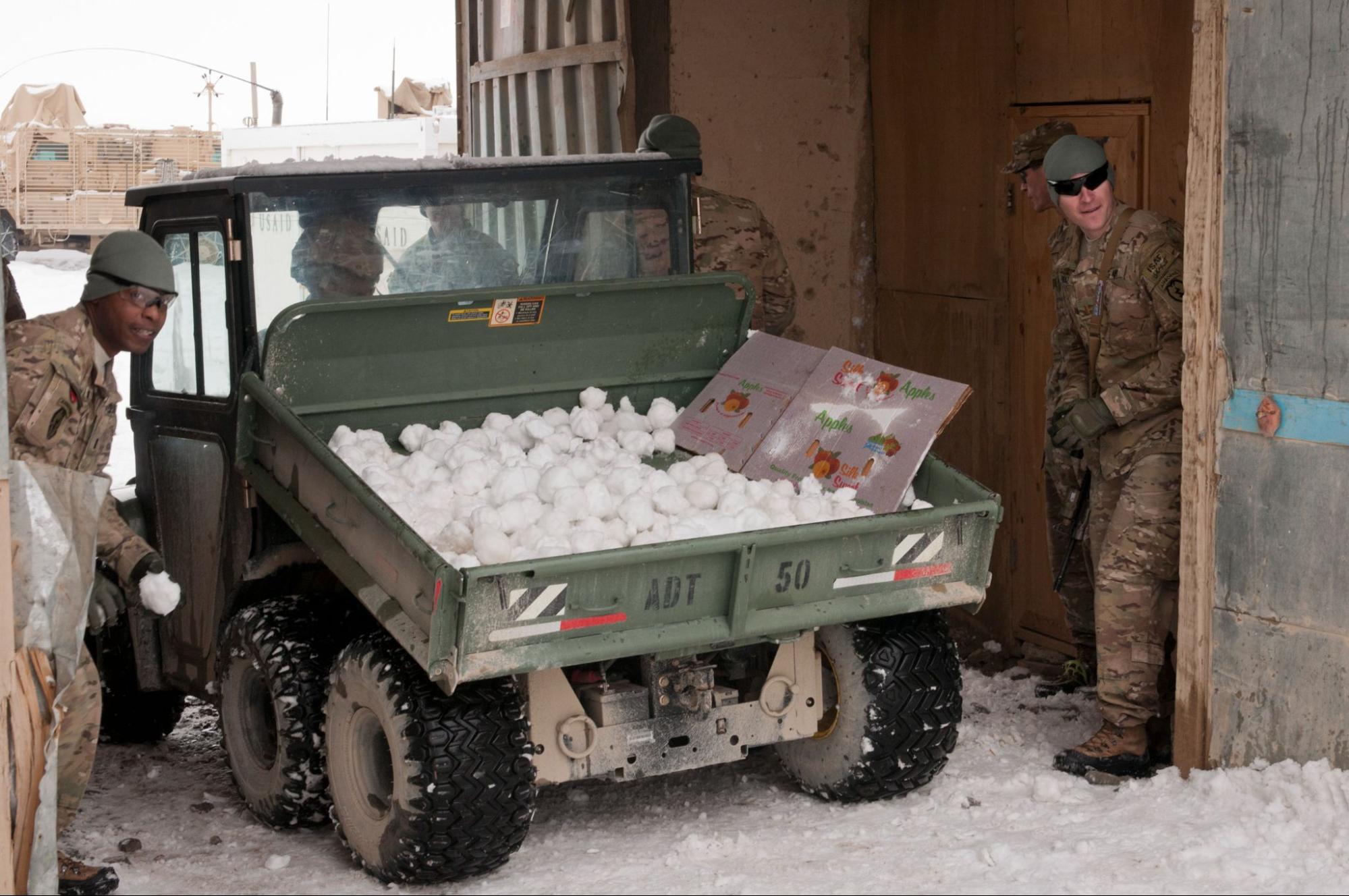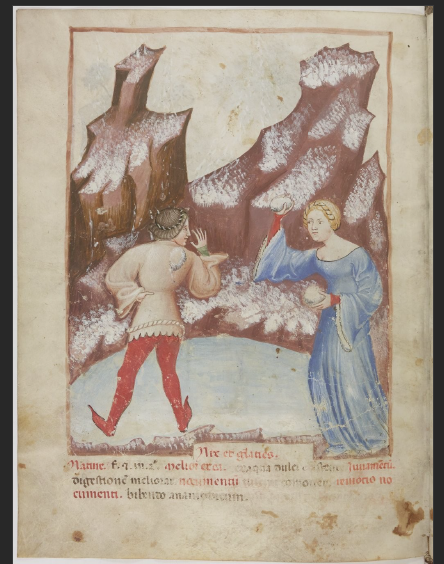1.1 Chapter Overview
Figure 1.1. 1897 year. Snowball fight colorized in 2021 [YouTube Video] (time 1.26 minutes). This video has music but no words.
In 2020 a video emerged on social media that depicts a curious scene from 1897 in Lyons, France (figure 1.1). Joyous adults are engaged in a snowball fight in the street. Women join in their work aprons. One man in coat-tails seems especially enthralled with the game. A bicyclist attempts to pedal through the scene but is pelted as well, causing him to fall heels-up in the snow.
The original version was shot by Auguste and Louis Lumière. The Lumière brothers are considered the fathers of cinematography for they had filmed the first motion picture two years previously, marking a major achievement in communications technology.
“Snow Fight’’ went viral in 2020 after amateur Russian photographer Joaquim Campa applied a new editing tool to colorize it and smooth out the motion (Anderson 2020). Take a look at the 58-second film. As you do, can you imagine why the scene is so fascinating to have made it go viral?
Below the video, one commenter exclaimed: “It’s surreal to watch people from more than a hundred years ago having fun in much the same way we would today”. NYTimes writer Sam Anderson (2020) wrote about his own fascination this way:
On an intellectual level, we all understand that historical people were basically just like us …The ancestors who laid down our roads and built our houses and planted the trees whose leaves still clog our gutters …They lived, as we do, in the throbbing nerve-pocket of the now. They were anxious and unsure, bored and silly. Nothing that would happen in their lifetimes had happened yet. The ocean of time was crashing fresh waves, nonstop, against the rocks of their days. And like us they stood there, gasping in the cold spray, wondering what people of the past were like.
1.1.1 Our Fascinating Lives
You’ve likely wondered what life was like a hundred years ago or so. You may have imagined if life was harder. Was it more enjoyable in some ways? How did people love and work? What was it like to raise children? “Snow Fight’’ may be fascinating to us because it allows us a peek into these mysteries. We wonder about these individuals, called away from their day to play in the snow.
1.1.1.1 Social realities
“Snow Fight’’ may also be fascinating to us because we know those individuals’ lives were shaped by societal realities of the time. Various social, cultural, and political circumstances – of the past and present- shaped the life experiences of each snowball fighter that winter in 1897. Equally important were environmental circumstances that impacted their lives and how they interacted.
1.1.1.2 Comparisons and social meaning
These kinds of images also grant us inspiration to make comparisons between the experiences of groups living at the same time. Consider figure 1.2, the photograph taken at Princeton University in 1893, snapped just after a snowball fight between freshman and sophomores. It seems this group had a much different encounter with their snowball fight than those in the Lumière film four years later. What social dynamics can you imagine were at play with the Columbia University students before this photograph was taken? Did snowball fights have a different meaning to them than residents of Lyons?

Figure 1.2. Photograph of bruised Princeton students looking disgruntled after a snowball fight between freshman and sophomores, 1893.
Images can also grant us inspiration to make comparisons between societies across time. Add to your analysis of the images above, by taking a look at some images of snowball fights around the world (Figures 1.3, 1.4, and 1.5). What social circumstances can you imagine existed during those scenes? What different meanings can you imagine were associated with the snowball fight across the centuries and locations represented?

Figure 1.3. A photo of a multipanel work by Taiso Yoshitoshi (1839–1892) that shows three women on a platform in Japan, observing a raucous snowball fight among people below. 1882.

Figure 1.4. A photo of two U.S. Army 1st Lieutenants at a US outpost in Afghanistan during a snowball fight. They flank fresh ammunition of snowballs collected in a truck. Taken on February 20, 2012.

Figure 1.5. Image of two people having a snowball fight found in Tacuinum sanitatis, an eleventh-century Arab medical treatise authored by Ibn Butlan of Baghdad. This image comes from a Latin edition produced in Lombardy, ca. 1400.
For example, the 1400-era rendition of a snowball fight in figure 1.5. It’s found in an Latin edition of the Tacuinum sanitatis, an eleventh-century Arab medical handbook by physician and philosopher Ibn Butlan of Baghdad. It is illustrated alongside writings of the benefits of regular attention to physical and mental well-being, including fresh air and alternations of activity and rest. The handbook was popular into the sixteenth century and marks the strong influence that Arab culture had on people living in early modern Europe (Loudon 2002). For thirteenth century residents of Lombardy we can gather that the snowball fight was integral to good health.
1.1.1.3 Universal experiences
This collection of images also confirms that snowball fights have been commonly practiced across societies for some time. Said another way, snowball fights are part of culturally universal expressions. In the social sciences, a cultural universal refers to an element, pattern, trait, or institution that is common to all human cultures worldwide. Snow is not available in all parts of the world, but play fighting and humor does exist universally. While social circumstances do change over time, and impact peoples’ lives differently, much also stays the same across centuries and continents.
1.1.2 Social Change, Your Community, and You
When we are inspired to imagine how social realities shape peoples’ lives, we are beginning to practice the art of sociology. As we wonder about the meaning that members of society place on activities like snowball fighting, then make comparisons to find differences or universal experiences, we are also practicing sociology. Similarly, when we look at the changes in society that influence those experiences, we practice the sociological study of social change.
This textbook will focus specifically on how sociology views and studies social change. We’ll define sociology and social change in the next pages. We’ll then explore how sociologists observe society, and how they apply data and diverse perspectives to understand the interactions between individuals and the society around them. We’ll explore the causes, impacts, and dynamics of social change, focusing on how societies are organized, current and historical events, and unequal relations of power. We’ll also explore ways of better understanding how to contribute to social change in a variety of settings: within civil society, government, or private agencies; as volunteer activists; or working in your chosen professions.
Before we dive into the discipline of sociology, we want to encourage you to look further into how social change matters to you and your community in your everyday lives. So, in Chapter 1 we’ll just touch on the meaning of sociology, and the importance of acknowledging diverse experiences as we practice sociology. We’ll save the start of our more academic content for Chapter 2.
In Chapter 1 we’ll look broadly at the era during which “Snow Fight” was filmed to show how we can make more connections. Then, to support your exploration of how social change matters to you, we’ll introduce some societies that we hope have different cultural expressions than what you are familiar with. We’ll highlight perspectives from three societies less entrenched in colonized and European influences: Sami people living near the Arctic Circle, war resisters of northern Colombia, then Quechua and Aymara communities of the Andes in South America. With those examples, we’ll explore these questions:
- How are experiences of social change based on diverse environmental circumstances, historical realities, and cultural perspectives?
- Specifically, how do Andean Indigenous communities, Colombian war resisters, and members of Sami communities experience social change?
It’s a powerful exercise to frame social change in the context of your own experience, and that of your community. So, this chapter also prompts you to explore:
- What does social change mean to you and your community according to the history, cultural perspectives, and environmental circumstances you have experienced?
1.1.2.1 Going Deeper
- See more photos of snowballing in this collection of “Snowball Fights in Art” from 1400–1946.
1.1.3 Licenses and Attributions for Chapter Overview
“Chapter Overview” by Aimee Krouskop is licensed under CC BY 4.0.
Figure 1.1. “1897 year. Snowball fight colorized in 2021” © not.bw. License Terms: Standard YouTube license.
Figure 1.2. Photograph of Princeton students after a snowball fight between freshman and sophomores, 1893 is in the Public domain, via Wikimedia Commons.
Figure 1.3. Photograph of a multipanel work by Taiso Yoshitoshi (1839–1892), 1882 is in the Public domain via Wikimedia Commons.
Figure 1.4. Photograph of two U.S. Army 1st Lieutenants at a US outpost in Afghanistan during a snowball fight is in the Public domain via Wikimedia Commons.
Figure 1.5. Snowball fight from Tacuinum sanitatis is in the Public domain, via Wikimedia Commons.
